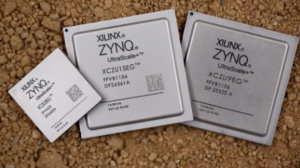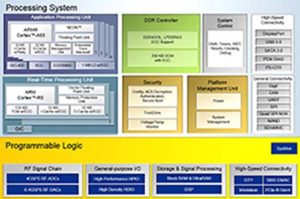 Xilinx, Inc. announced delivery of its Zynq UltraScale+ RFSoC family that integrates the RF signal chain into an SoC for 5G wireless, cable Remote-PHY, and radar. Based on 16nm UltraScale+ MPSoC architecture, the All Programmable RFSoCs monolithically integrate RF data converters for up to 50-75 percent system power and footprint reduction, and soft-decision Forward Error Correction (SD-FEC) cores to meet 5G and DOCSIS 3.1 standards. With silicon samples already shipping to multiple customers, the early access program for the Zynq UltraScale+ RFSoC family is now available.
Xilinx, Inc. announced delivery of its Zynq UltraScale+ RFSoC family that integrates the RF signal chain into an SoC for 5G wireless, cable Remote-PHY, and radar. Based on 16nm UltraScale+ MPSoC architecture, the All Programmable RFSoCs monolithically integrate RF data converters for up to 50-75 percent system power and footprint reduction, and soft-decision Forward Error Correction (SD-FEC) cores to meet 5G and DOCSIS 3.1 standards. With silicon samples already shipping to multiple customers, the early access program for the Zynq UltraScale+ RFSoC family is now available.
Zynq RFSoCs combine RF data converters and SD-FEC cores with high performance 16nm UltraScale+ programmable logic and ARM® multi-processing system to create a comprehensive analog-to-digital signal chain. While RF to digital signal conditioning and processing is typically segmented into stand-alone subsystems, the Zynq UltraScale+ RFSoC brings analog, digital, and embedded software design onto a single monolithic device for system robustness. Devices in the family feature:
- Eight 4GSPS or sixteen 2GSPS 12-bit ADCs
- Eight to sixteen 6.4GSPS 14-bit DACs
- Integrated SD-FEC cores with LDPC and Turbo codecs for 5G and DOCSIS 3.1
- ARM processing subsystem with Quad-Core Cortex™-A53 and Dual-Core Cortex™-R5s
- 16nm UltraScale+ programmable logic with integrated Nx100G cores
- Up to 930,000 logic cells and over 4,200 DSP slices
Applications addressed by the Zynq RFSoC family include remote radio head for massive-MIMO, millimeter wave mobile backhaul, 5G baseband, fixed wireless access, Remote-PHY nodes for cable, radar, test & measurement, SATCOM, and Milcom / Airborne Radio and other high-performance RF applications.
 Zynq UltraScale+ RFSoC devices now make viable the most bandwidth intensive systems for next generation wireless infrastructure. 5G imperatives—ranging from 5X bandwidth, 100X user data rates, and 1000X greater network capacity—would be unattainable without breakthroughs at the system level. The integration of discrete RF data converters and signal chain optimization in Zynq UltraScale+ RFSoCs allow remote radio head for Massive-MIMO, wireless backhaul, and fixed wireless access to realize high channel density with 50-75 percent power and footprint reduction. Multiple integrated SD-FEC cores enable 10-20X system throughput vs. a soft-core implementation for 5G baseband within stringent power and thermal constraints.
Zynq UltraScale+ RFSoC devices now make viable the most bandwidth intensive systems for next generation wireless infrastructure. 5G imperatives—ranging from 5X bandwidth, 100X user data rates, and 1000X greater network capacity—would be unattainable without breakthroughs at the system level. The integration of discrete RF data converters and signal chain optimization in Zynq UltraScale+ RFSoCs allow remote radio head for Massive-MIMO, wireless backhaul, and fixed wireless access to realize high channel density with 50-75 percent power and footprint reduction. Multiple integrated SD-FEC cores enable 10-20X system throughput vs. a soft-core implementation for 5G baseband within stringent power and thermal constraints.
Similarly, in next-generation cable broadband services, Zynq RFSoCs provide a combination of small form factor, power efficiency, and hardware flexibility to enable Remote-PHY systems. Distributed access architectures push DOCSIS 3.x PHY functionality from the centralized headend equipment to the Remote-PHY node located closer to consumers. By replacing inefficient analog optical transmission with ubiquitous Ethernet transport, network capacity, scale and performance improvements. With RF integration and an LDPC FEC-enabled signal chain, RFSoCs ensure flexible R-PHY deployment for greater spectral efficiency prescribed by DOCSIS3.1.
Zynq RFSoCs also deliver the needed performance and adaptability for key government programs such as the Multi-function Phased Array Radar (MPAR) initiative to combine the functions of several national radar networks into a single system for aircraft and weather surveillance. Because tleading-edge edge systems must operate in real time, the inherent integration of RF-Analog makes the Zynq UltraScale+ RFSoC an ideal solution. Zynq RFSoC devices are currently designed into the Rockwell Collins’ Common Module beamformer for the DARPA Arrays at Commercial Time Scales (ACT) program, which aims to shorten design cycles and in-field updates, while pushing past traditional barriers for delivering radar arrays.
Zynq UltraScale+ RFSoC device samples are shipping now. Vivado® Design Suite early access supporting Zynq UltraScale+ RFSoC devices is now available. Customers interested in the Zynq UltraScale+ RFSoC early access program can contact their local Xilinx representative. For more information, please visit: xilinx.com/rfsoc.


Leave a Reply
You must be logged in to post a comment.